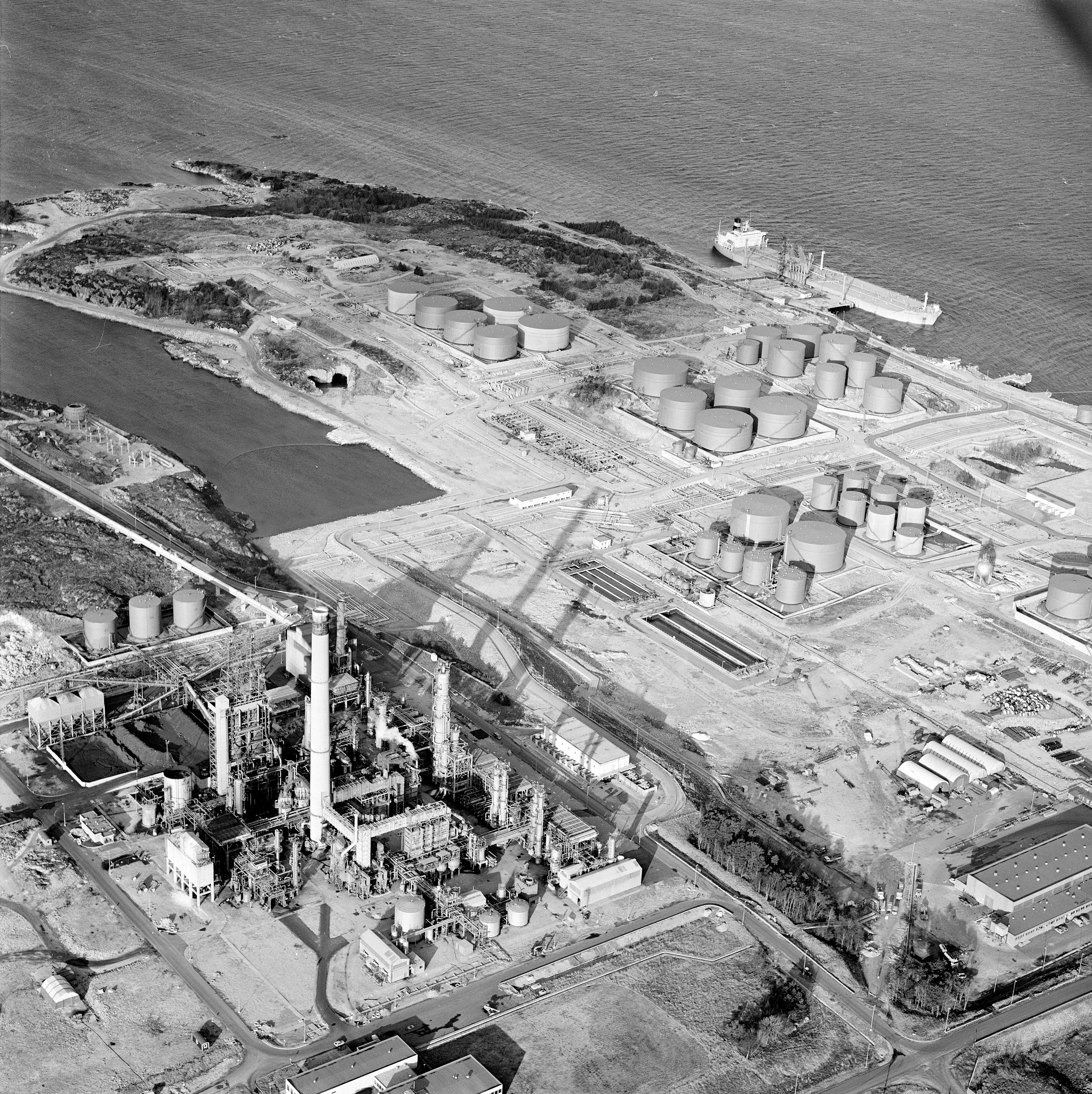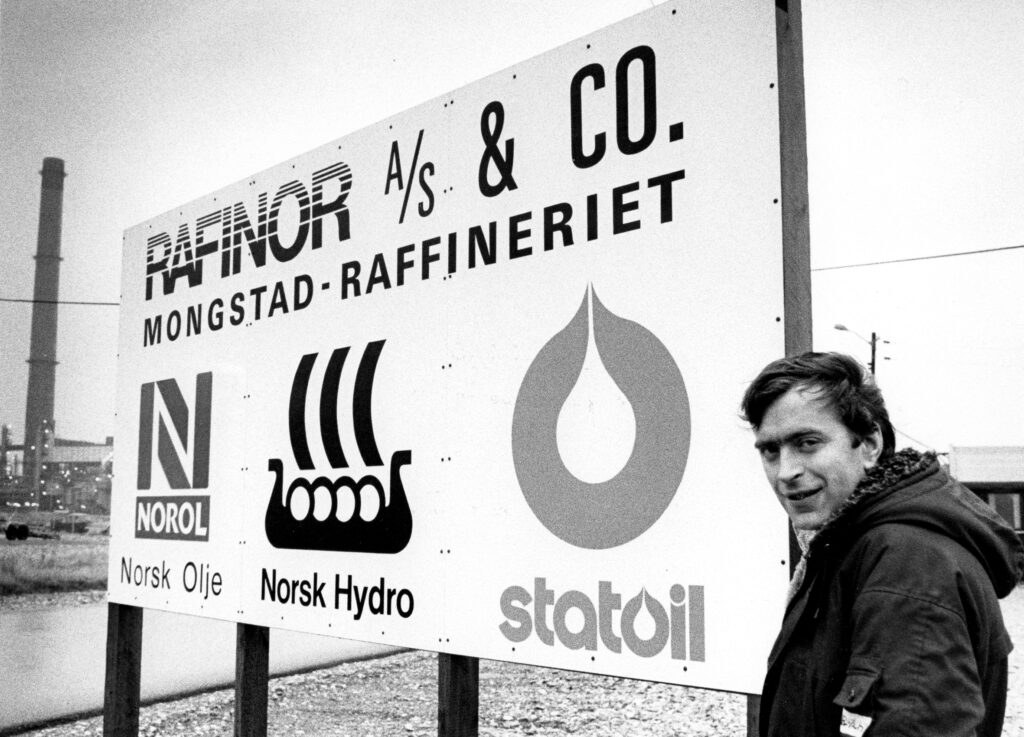“One of Norway’s biggest postwar industrial ventures”

The role played by the Mongstad refinery in the new oil nation varied during the 1970s. As the Statfjord and Gullfaks fields were developed, Statoil and the government secured large supplies of crude. It was natural, in their view, that at least part of this feedstock be refined in Norway – at Mongstad. In 1979, Statoil secured a majority shareholding there while Hydro retained 30 per cent. The question is how the latter went from initiator and main shareholder to becoming the junior partner in this facility.
Start to refining
When Mongstad was designated for industrial development in the late 1960s, several companies were interested in exploiting this site outside Bergen. Hydro won the day because it could promise more jobs than the others.[REMOVE]Fotnote: Johannessen, F E, Rønning, Asle and Sandvik, Pål Thonstad, 2005, Nasjonal kontroll og industriell fornyelse: Hydro 1945-1977: vol B 2: 468, Pax: 344. The plan was to build an oil refinery.

Hydro signed an agreement in November 1971 with Norsk Brændselsolje (NB) to construct this facility. The former had 60 per cent of the shares. NB was owned 50 per cent by BP, with Norwegians as the remaining shareholders.[REMOVE]Fotnote: Ibid: 342.
It is worth noting that the idea of a refinery took hold even before Ekofisk was discovered in 1969, but things really got off the ground after that. With construction starting in 1972,[REMOVE]Fotnote: https://snl.no/Mongstad, accessed 5 November 2020. the facility became operational in 1975 but a fire that year meant production did not get properly under way until 1976. It had three main components – crude oil distillation, a reforming section for petrol and a plant to produce special coke for the aluminium industry.[REMOVE]Fotnote: Anon, 1990, “Perioden 1970-1976”, 70 år: 1920-1990, Oslo: 24.
Hydro and NB organised the refinery through Rafinor A/S on the mill principle. Just as the farmer owned the grain put through a mill and the resulting flour, the two partners owned the crude oil and the refined products. The refinery charged a fee for the actual processing to cover operating costs, interest charges and debt instalments, as well as yielding some profit to the owners.[REMOVE]Fotnote: Nerheim, Gunnar, 1996, En gassnasjon blir til, vol 2, Norsk oljehistorie, Leseselskapet: 210.
Mongstad had a distillation capacity of four million tonnes of crude per annum.[REMOVE]Fotnote: Report no 98 (1983-84) to the Storting, Om moderniseringa av Mongstad-raffineriet: 17. That was more than enough for refining Hydro’s share of Ekofisk crude and the oil products NB required for its service stations. But another Norwegian company which would eventually require refinery capacity was Statoil. The question was whether the two existing owners should invite the latter to buy into the Mongstad plant.
Keep your friends close and your competitors closer
Norway was a young oil nation in the early 1970s. Statoil had been established in 1972, but it took time before it became clear how this newcomer would affect Hydro’s role as an oil company owned 50 per cent by the state. Statoil had big support from Labour, and CEO Arve Johnsen believes the party’s election victory in 1973 was crucial for the direction Norway’s oil and gas policy took.[REMOVE]Fotnote: Johannessen, F E et al, op.cit: 335.
In March 1974, management in Hydro and NB discussed how far an expansion of Mongstad ought to include Statoil. Hydro CEO Johan B Holte believed the latter should be excluded.[REMOVE]Fotnote: Nerheim, Gunnar, op.cit: 212. Part of this scepticism towards Statoil could have reflected his poor personal relationship with Johnsen.[REMOVE]Fotnote: Johnsen, Arve, 2008, Norges evige rikdom: 27-28.

Torvild Aakvaag, head of Hydro’s oil division, took the view that it would be smart to collaborate with the new and favoured oil company. “By collaborating with Statoil, we can get these political forces to work for instead of against us,” he commented.[REMOVE]Fotnote: Johannessen, F E et al, op.cit: 347-348. Moreover, the danger existed that Statoil would establish its own competing refinery. Better to invite it in, Aakvaag maintained. This could also yield economies of scale.[REMOVE]Fotnote: Nerheim, Gunnar, op.cit: 212. In other words, the lesser of two evils was probably to forge close ties to the competitor.
A couple of years nevertheless passed before Statoil secured a shareholding in Mongstad. This occurred in 1976, when the state acquired NB along with a number of other Norwegian service stations. The new company was named Norsk Olje (Norol). In addition to NB’s petrol forecourts, the acquisition included its share of Rafinor.
At the same time, Statoil acquired half of Hydro’s shares in the refinery to give it a 30 per cent holding.
The sale freed up capital for the seller, which could be used in other parts of its business. NOK 298 million was a good price, given that the market for refined products was poor – something Hydro’s management was aware of, but not the government negotiators.[REMOVE]Fotnote: Johannessen, F E et al, op.cit: 351.
Nationalisation

Since Statoil and Norol were both wholly state-owned and held a total of 70 per cent of the Rafinor shares in 1976, it can be argued that the refinery was nationalised. “From being the initiator, Hydro was reduced to a junior partner,” as one assessment puts it.[REMOVE]Fotnote: Ibid: 350.
Statoil’s position at Mongstad became even stronger towards the end of the 1970s. The first attempt at such reinforcement was made in the spring of 1978, when the Labour government proposed that Norol should sell its Rafinor shares to Statoil in order to strengthen its finances. That was rejected by the Storting. A year later, however, Statoil secured a majority of the Norol shares.
Although Norol remained a separate company, Statoil had nevertheless effectively obtained the largest shareholding at Mongstad. It eventually became clear that the company had big plans for the refinery.
